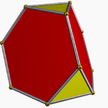Truncated cuboctahedron
| Truncated cuboctahedron | |
|---|---|
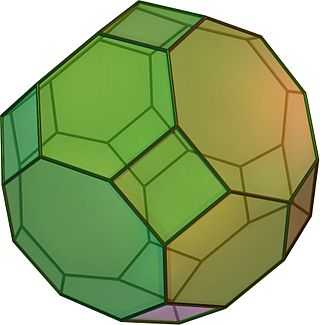 (Click here for rotating model) | |
| Type | Archimedean solid Uniform polyhedron |
| Elements | F = 26, E = 72, V = 48 (χ = 2) |
| Faces by sides | 12{4}+8{6}+6{8} |
| Conway notation | bC or taC |
| Schläfli symbols | tr{4,3} or  |
| t0,1,2{4,3} | |
| Wythoff symbol | 2 3 4 | |
| Coxeter diagram | |
| Symmetry group | Oh, BC3, [4,3], (*432), order 48 |
| Rotation group | O, [4,3]+, (432), order 24 |
| Dihedral Angle | 4-6:cos(-sqrt(6)/3)=144°44'08" 4-8:cos(-sqrt(2)/3)=135° 6-8:cos(-sqrt(3)/3)=125°15'51" |
| References | U11, C23, W15 |
| Properties | Semiregular convex zonohedron |
 Colored faces |
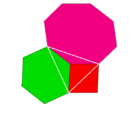 4.6.8 (Vertex figure) |
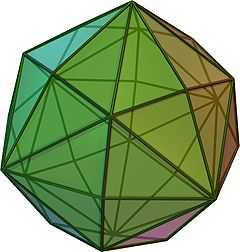 Disdyakis dodecahedron (dual polyhedron) |
 Net |
In geometry, the truncated cuboctahedron is an Archimedean solid. It has 12 square faces, 8 regular hexagonal faces, 6 regular octagonal faces, 48 vertices and 72 edges. Since each of its faces has point symmetry (equivalently, 180° rotational symmetry), the truncated cuboctahedron is a zonohedron.
Other names
Alternate interchangeable names are:
- Truncated cuboctahedron (Johannes Kepler)
- Rhombitruncated cuboctahedron (Magnus Wenninger[1])
- Great rhombicuboctahedron (Robert Williams[2])
- Great rhombcuboctahedron (Peter Cromwell[3])
- Omnitruncated cube or cantitruncated cube (Norman Johnson)
The name truncated cuboctahedron, given originally by Johannes Kepler, is a little misleading. If you truncate a cuboctahedron by cutting the corners off, you do not get this uniform figure: some of the faces will be rectangles. However, the resulting figure is topologically equivalent to a truncated cuboctahedron and can always be deformed until the faces are regular.
The alternative name great rhombicuboctahedron refers to the fact that the 12 square faces lie in the same planes as the 12 faces of the rhombic dodecahedron which is dual to the cuboctahedron. Compare to small rhombicuboctahedron.
One unfortunate point of confusion: There is a nonconvex uniform polyhedron by the same name. See nonconvex great rhombicuboctahedron.
Cartesian coordinates
The Cartesian coordinates for the vertices of a truncated cuboctahedron having edge length 2 and centered at the origin are all permutations of:
- (±1, ±(1+√2), ±(1+2√2))
Area and volume
The area A and the volume V of the truncated cuboctahedron of edge length a are:
Dissection
The truncated cuboctahedron can be dissected into a central rhombicuboctahedron, with 6 square cupolas above each primary square face, 8 triangular cupola above each triangular face, and 12 cubes above the secondary square faces.
A dissected truncated cuboctahedron can create a genus 5, 7 or 11 Stewart toroid by removing the central rhombicuboctahedron and either the square cupola, the triangular cupola or the 12 cubes respectively. Many other lower symmetry toroids can also be constructed by removing a subset of these dissected components. For example, removing half of the triangular cupola creates a genus 3 torus, which (if they are chosen appropriately) has tetrahedral symmetry. [4][5]
| Genus 3 | Genus 5 | Genus 7 | Genus 11 |
|---|---|---|---|
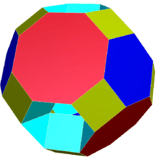 |
 |
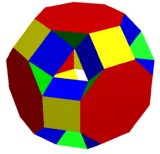 |
 |
Uniform colorings
There is only one uniform coloring of the faces of this polyhedron, one color for each face type.
A 2-uniform coloring, with tetrahedral symmetry, exists with alternately colored hexagons.
Orthogonal projections
The truncated cuboctahedron has two special orthogonal projections in the A2 and B2 Coxeter planes with [6] and [8] projective symmetry, and numerous [2] symmetries can be constructed from various projected planes relative to the polyhedron elements.
| Centered by | Vertex | Edge 4-6 |
Edge 4-8 |
Edge 6-8 |
Face normal 4-6 |
|---|---|---|---|---|---|
| Image |  |
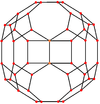 |
 |
 |
 |
| Projective symmetry |
[2]+ | [2] | [2] | [2] | [2] |
| Centered by | Face normal Square |
Face normal Octagon |
Face Square |
Face Hexagon |
Face Octagon |
| Image |  |
 |
 |
 |
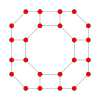 |
| Projective symmetry |
[2] | [2] | [2] | [6] | [8] |
Spherical tiling
The truncated cuboctahedron can also be represented as a spherical tiling, and projected onto the plane via a stereographic projection. This projection is conformal, preserving angles but not areas or lengths. Straight lines on the sphere are projected as circular arcs on the plane.
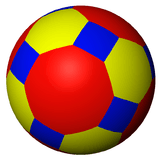 |
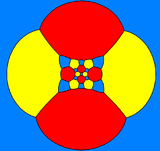 square-centered |
 hexagon-centered |
 octagon-centered |
| Orthogonal projection | Stereographic projections | ||
|---|---|---|---|
Related polyhedra
The truncated cuboctahedron is one of a family of uniform polyhedra related to the cube and regular octahedron.
| Symmetry: [4,3], (*432) | [4,3]+ (432) |
[1+,4,3] = [3,3] (*332) |
[3+,4] (3*2) | |||||||
|---|---|---|---|---|---|---|---|---|---|---|
| {4,3} | t{4,3} | r{4,3} r{31,1} |
t{3,4} t{31,1} |
{3,4} {31,1} |
rr{4,3} s2{3,4} |
tr{4,3} | sr{4,3} | h{4,3} {3,3} |
h2{4,3} t{3,3} |
s{3,4} s{31,1} |
= |
= |
= |
||||||||
| Duals to uniform polyhedra | ||||||||||
| V43 | V3.82 | V(3.4)2 | V4.62 | V34 | V3.43 | V4.6.8 | V34.4 | V33 | V3.62 | V35 |
This polyhedron can be considered a member of a sequence of uniform patterns with vertex figure (4.6.2p) and Coxeter-Dynkin diagram ![]()
![]()
![]()
![]()
![]() . For p < 6, the members of the sequence are omnitruncated polyhedra (zonohedrons), shown below as spherical tilings. For p > 6, they are tilings of the hyperbolic plane, starting with the truncated triheptagonal tiling.
. For p < 6, the members of the sequence are omnitruncated polyhedra (zonohedrons), shown below as spherical tilings. For p > 6, they are tilings of the hyperbolic plane, starting with the truncated triheptagonal tiling.
| Sym. *n32 [n,3] |
Spherical | Euclid. | Compact hyperb. | Paraco. | Noncompact hyperbolic | |||||||
|---|---|---|---|---|---|---|---|---|---|---|---|---|
| *232 [2,3] D3h |
*332 [3,3] Td |
*432 [4,3] Oh |
*532 [5,3] Ih |
*632 [6,3] P6m |
*732 [7,3] |
*832 [8,3] |
*∞32 [∞,3] |
[12i,3] |
[9i,3] |
[6i,3] |
[3i,3] | |
| Figure |  |
 |
 |
 |
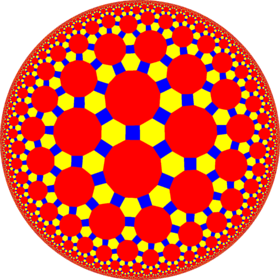 |
 |
 |
 |
 |
 |
 | |
| Schläfli | tr{2,3} | tr{3,3} | tr{4,3} | tr{5,3} | tr{6,3} | tr{7,3} | tr{8,3} | tr{∞,3} | tr{12i,3} | tr{9i,3} | tr{6i,3} | tr{3i,3} |
| Coxeter | ||||||||||||
| Dual figures | ||||||||||||
| Coxeter | ||||||||||||
| Duals |  |
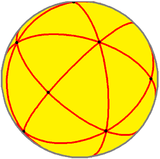 |
 |
 |
 |
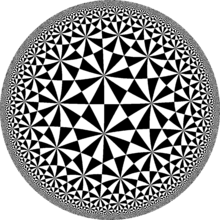 |
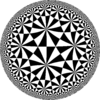 |
 |
 |
 |
 |
 |
| Face | V4.6.4 | V4.6.6 | V4.6.8 | V4.6.10 | V4.6.12 | V4.6.14 | V4.6.16 | V4.6.∞ | V4.6.24i | V4.6.18i | V4.6.12i | V4.6.6i |
| Symmetry *n42 [n,4] |
Spherical | Euclidean | Compact hyperbolic | Paracompact | ||||
|---|---|---|---|---|---|---|---|---|
| *242 [2,4] D4h |
*342 [3,4] Oh |
*442 [4,4] P4m |
*542 [5,4] |
*642 [6,4] |
*742 [7,4] |
*842 [8,4]... |
*∞42 [∞,4] | |
| Omnitruncated figure |
 4.8.4 |
 4.8.6 |
 4.8.8 |
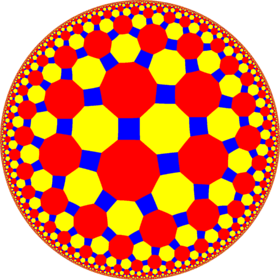 4.8.10 |
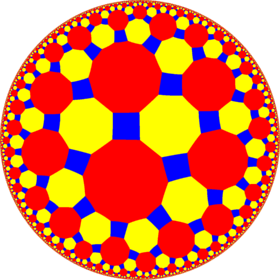 4.8.12 |
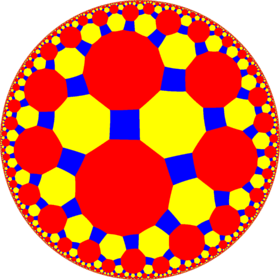 4.8.14 |
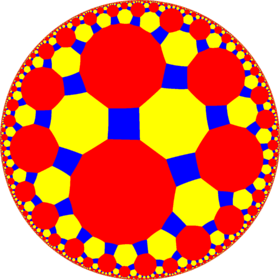 4.8.16 |
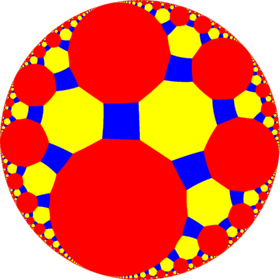 4.8.∞ |
| Coxeter Schläfli |
tr{2,4} |
tr{3,4} |
tr{4,4} |
tr{5,4} |
tr{6,4} |
tr{7,4} |
tr{8,4} |
tr{∞,4} |
| Omnitruncated duals |
V4.8.4 |
 V4.8.6 |
 V4.8.8 |
 V4.8.10 |
 V4.8.12 |
 V4.8.14 |
 V4.8.16 |
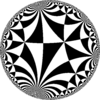 V4.8.∞ |
| Coxeter | ||||||||
Truncated cuboctahedral graph
| Truncated cuboctahedral graph | |
|---|---|
|
4-fold symmetry | |
| Vertices | 48 |
| Edges | 72 |
| Automorphisms | 48 |
| Chromatic number | 2 |
| Properties | Cubic, Hamiltonian, regular, zero-symmetric |
In the mathematical field of graph theory, a truncated cuboctahedral graph (or great rhombcuboctahedral graph) is the graph of vertices and edges of the truncated cuboctahedron, one of the Archimedean solids. It has 48 vertices and 72 edges, and is a zero-symmetric and cubic Archimedean graph.[6]
See also
| Wikimedia Commons has media related to Truncated cuboctahedron. |
- Cube
- Cuboctahedron
- Octahedron
- Truncated icosidodecahedron
- Truncated octahedron – truncated tetratetrahedron
References
- ↑ Wenninger, Magnus (1974), Polyhedron Models, Cambridge University Press, ISBN 978-0-521-09859-5, MR 0467493 (Model 15, p. 29)
- ↑ Williams, Robert (1979). The Geometrical Foundation of Natural Structure: A Source Book of Design. Dover Publications, Inc. ISBN 0-486-23729-X. (Section 3-9, p. 82)
- ↑ Cromwell, P.; Polyhedra, CUP hbk (1997), pbk. (1999). (p. 82)
- ↑ B. M. Stewart, Adventures Among the Toroids (1970) ISBN 978-0-686-11936-4
- ↑ http://www.doskey.com/polyhedra/Stewart05.html
- ↑ Read, R. C.; Wilson, R. J. (1998), An Atlas of Graphs, Oxford University Press, p. 269
- Cromwell, P. (1997). Polyhedra. United Kingdom: Cambridge. pp. 79–86 Archimedean solids. ISBN 0-521-55432-2.
External links
- Eric W. Weisstein, Great rhombicuboctahedron (Archimedean solid) at MathWorld
- Richard Klitzing, 3D convex uniform polyhedra, x3x4x - girco
- Editable printable net of a truncated cuboctahedron with interactive 3D view
- The Uniform Polyhedra
- Virtual Reality Polyhedra The Encyclopedia of Polyhedra
- great Rhombicuboctahedron: paper strips for plaiting
| ||||||||||||||||||||||||||||||||||||



